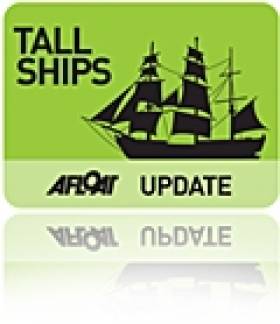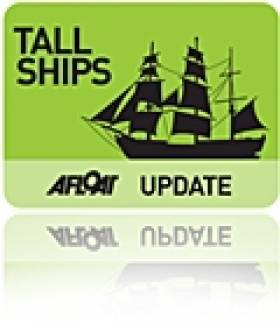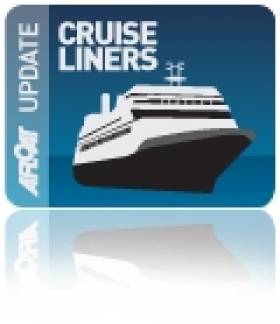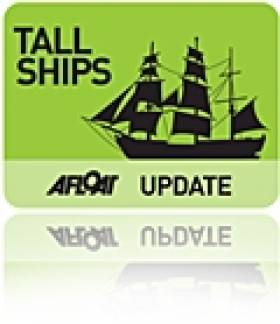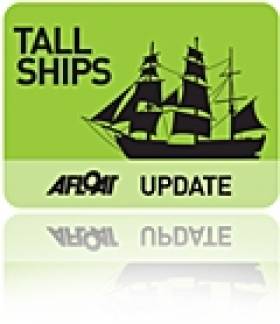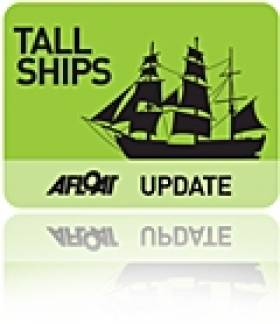Displaying items by tag: Dublin Tall Ships Race Festival
Norwegian School Tallship to Make Return Call to Capital
#TALL SHIP -The Norwegian three-mast school ship Christian Radich is to visit Dublin Port tomorrow as part of a four-day stopover, writes Jehan Ashmore.
The 1937 built tallship will make her main port of call to the capital during a four week sailing programme arranged by Norwegian Navy Officer Candidate School.
She called to Dublin Port last year, as previously reported on Afloat.ie for publicity purposes in advance of this year's successful festival in the capital which was host to the final port of call of the Tall Ships Races. Likewise of the tallships, she is to berth alongside the Liffey at Sir John Rogersons Quay.
For further details of the tallship whose homeport is Oslo and also the principle characteristics of the vessel click this LINK.
Semester at Sea Ship Sets Sail Amid a ‘Blaze of Light’
#SEMESTER-SHIP – Last night the semester at sea cruiseship Explorer with more than 800 students, academics and crew, as previously reported on Afloat.ie, departed into Dublin Bay in a blaze of light, having visited the capital for a two-days, writes Jehan Ashmore.
It was rather unusual to see a vessel bedecked with the special display, where the lighting arrangement was strung from stem to stern along the 180m long. On board the 25,000 tonnes vessel where students from the University of Ohio, who are taking a 'semester at sea' world cruise programme operated by the not-for-profit initiative organised by the Institute for Shipboard Education in co-operation with the university.
The nightime visual spectacle, is similar to the daylight version of a ship 'dressed overall' (using the nautical flags) as perfectly demonstrated by the Tall Ships participant barque Cuauhtemoc of the Mexican Navy, as previously reported on Afloat.ie. Noting aerial video footage of her arrival to Dublin Port and featured in the accompanying Parade of Sail gallery.
As Explorer proceeded further out of Dublin Bay, and into the open sea, the special lighting display was switched off. She set a course for the Kish Bank Lighthouse and the vessel is currently off Cornwall and heading up the English Channel.
Dublin Tall Ships ‘Parade of Sail’ Gun Salute Relocates from Dun Laoghaire Harbour to Poolbeg
#PARADE OF SAIL UPDATE– A gun salute for today's Dublin Tall Ship Festival climax of the 'Parade of Sail' will now take place at Poolbeg in Dublin Port, rather then Dun Laoghaire Harbour as previously reported, however the tallships will remain on a course to pass off the harbour entrance, writes Jehan Ashmore.
The first tallship to bid Dublin farewell, is to depart at 11.00 this morning, and once they pass the Poolbeg Lighthouse, they will then proceed on a course heading for Dun Laoghaire Harbour. Noting the first tallship is expected to pass off the harbour around 11.45am and the last ship is due around 2.15pm.
Awaiting the fleet in Dublin Bay will be the Naval Service OPV L.E. Emer (P21) which will be anchored north north-east (0.5miles) off the East Pier, Dun Laoghaire Harbour. The tallships will round pass the L.E. Emer and then change course by heading for the Dublin Bay Buoy in the centre of the bay and head for the Baily Lighthouse on Howth Peninsula.
There will vantage points throughout the coastline of Dublin Bay, with the South Wall in Dublin Port, the west and east piers of Dun Loaghaire Harbour and along Howth Peninsula, been particularly good locations to witness what should no doubt be a memorable day as these glorious ships of sail head off over the horizon to many a distant shore.
When the fleet arrives off Howth Peninsula, they will divide into two, as 11 tallships will gather to form a smaller fleet which are to take part in the inaugural Irish Sea Tall Ships Regatta. This new event sees these tallships racing between Dublin to Liverpool.
Lirica's Call Again Brings ‘Added Value’ to the Capital
#LIRICA CALLS AGAIN – Only on her second cruise call to Dublin Port, MSC Lirica (2003/59,058grt) as previously reported on Afloat.ie, docked this morning into the capital brimming with tallships, adding another attraction for cruise-goers, writes Jehan Ashmore.
The $250m ship, made her maiden call to Ireland just over a fortnight ago with over 3,000 passengers. The 251m long vessel operated by Mediterranean Shipping Company (MSC) Cruises, which is the newest company to enter the Irish market and in total there are 90 callers to Dublin Port in 2012.
In May next year the port is to welcome another MSC Cruises vessel with the larger 293m MSC Magnifica, which cost $547million and was only completed in 2010.
The value of the sector is estimated to generate €35 and €50 million for the local economy, bringing over 100,000 high-spend passengers and crew to the city and surrounding areas' shops, attractions and eateries each year.
Add to that, an estimated 1 million visitors over the four-day Tall Ships festival, not to mention the international crew of 1,500 and attendant publicity. Albeit the tallships festival in Dublin is an infrequent event as it was held in the capital in 1998.
However this is the opposite with the expanding cruise business sector, where increasingly larger liners are making more regular calls. In order to cope with capacity the Dublin Port Company's Masterplan 2012-2040 has proposed a new €110m cruise terminal identified beside the East Link toll-lift bridge, recent witness to the numerous tallships passing through.
On a nationwide basis, over the last two years, it has been estimated that the cruise ship industry has contributed €20.3 million. Noting many cruise-callers make visits to more than one Irish port, particularly those calling to the premier ports, where economic opportunities for the hinterland's could be worth a potential €60 million over the next few years.
The Swiss headquartered MSC group don't just operate cruiseships, and are not new to Ireland, as for several years through their global container shipping division, its operation here, MSC (Ireland) started providing direct container shipping routes.
Initially they used their own tonnage (later chartered vessels) from one of the world's largest containership fleets, where the MSC compass brand symbol can be seen on the mixed fleet but also on the containers themselves.
‘Irish’ Tallships Are Thin and Small On the Sea-Ground
#IRISH TALLSHIPS – Of the 40-plus tallships participating in the Dublin Tallships Race Festival, only two vessels are Irish, and as previously reported on Afloat.ie, there have been calls to have a new cross-border national sail training flagship reinstated, writes Jehan Ashmore.
What represents Ireland, are not large A-class tallships but smaller vessels in the form of the Naval Reserve training Bermuda ketch STV Creidne (C-class) and the Kinsale based schooner Spirit of Oysterhaven (D-class), which sailed through Dalkey Sound yesterday morning.
It is a stark contrast to the glory days of when the Irish tallships, met together for a historic first and only gathering at the inaugural Waterford Tall Ships Race Festival back in 2006. The tallship trio were brigantine Asgard II (which sank in 2008) and the barques Dunbrody and Jeanie Johnston.
The unique gathering took place during the 'Parade of Sail' in Waterford Estuary, where Asgard II was given the honour in leading the fleet, followed by her fellow Irish fleetmates and the rest of the international flotilla.
Both the replica 19th century Dunbrody and Jeanie Johnston remain in a static role in New Ross, Co. Wexford and in Dublin Docklands, where they serve as floating museums, telling the story of emigration and the famine ships.
During the Dublin Tallships Festival, the Jeanie Johnston will be open to the public free of charge throughout the weekend from 10am to 5pm (last entry) and is on a first come first basis.
Entry to the barque is courtesy of Dublin Docklands Development Authority which purchased the vessel in 2005. For further information visit: www.jeaniejohnston.ie/index.html
#PARADE OF SAIL – In preparation for this Sunday's Tall Ships climax of the 'Parade of Sail', a rehearsal 21 Gun Salute will take place today at 14.00hrs at the East Pier Battery, in Dun Loaghaire Harbour, writes Jehan Ashmore.
After the four-day festival ends on Sunday, the tallships are to depart from Dublin Port at 11am, led by the Naval Service LE Emer (P21) with the three hour long 'Parade of Sail' into Dublin Bay. The 40-plus fleet will set a course along a corridor bound for Dun Laoghaire Harbour before turning around and steering for the Baily Lighthouse on Howth.
To mark the sailing spectacle, the battery in Dun Laoghaire Harbour will perform the 21 Gun Salute at approximately 11.45hrs. The criss-crossing of the Parade of Sail route will provide great shore-based spectator vantage points along both east and west piers of the harbour and on Howth Peninsula.
Gun salutes are, by nature, a noise hazard and the public are advised to keep 'well clear of the area' during the time of rehearsal and the gun salute. Blank ammunition will be fired for both the rehearsal and the gun salute.
The battery is equipped with 12-pounder naval guns and they have traditionally been, and remain, the responsibility of the 2nd Field Artillery Regiment, McKee Barracks, in Dublin.
Italian Navy Tallship Makes An Impressive Entrance
#TALLSHIPS – The Italian Navy's full-rigged training ship, Amerigo Vespucci, made a lunchtime arrival to Dublin Port today, where she then proceeded to make an impressive entrance through the East-Link bridge, in order to reach her 'Docklands' berth, writes Jehan Ashmore.
She had earlier appeared on the horizon south of the Kish Bank Lighthouse and what makes her easy to recognise is her distinctive hull livery. Unlike most white-painted tallships, the three-masted ship sports striking black and white hull, with each strip marking one of her three decks. Standing above these decks are her rigging, where her masts tower above the seas and at a height of nearly 63 metres.
Prior to her arrival, another naval sail training ship, the barque Cuauhtemoc, of the Mexican Navy docked into the capital having made a late morning call. A week ago she became the first over the finishing line off the Tuskar Rock, marking the final leg of the race from Spain.
Looking particularly smart, the vessel was 'dressed overall' upon her arrival with a large Mexican flag flying proudly at the stern. She too passed through the East-Link bridge and like Amerigo Vespucci, is moored alongside Sir John Rogersons Quay.
Astern of her was the UK flagged gaff ketch Maybe which has been in Howth Harbour in recent days. She berthed opposite the Cuauhtemoc at North Wall Quay.
A total of nine Tall Ships will have free access to the public at different times over the weekend, available on a first come first served basis.
In regards to the Amerigo Vespucci, she will be open today, from 3pm to 7pm, and tomorrow from 10.30am to 1pm and 3pm to 6pm. On Saturday the times are from 10.30am to 1pm and 3pm to 7pm.
Opening hours for the Cuauhtemoc, will be open till 7pm today, and from 10am till 11pm tomorrow and Saturday. For the full list of vessels and respective opening hours visit www.dublintallships.ie/fleet/
A notable festival highlight, is the 'Crew Parade' which is on tomorrow (Friday) between 3-4pm. Crews from around the world will march from the North Wall Quay and finish at the Custom House for a special prize giving ceremony.
More Big Tallships Due for Start of Dublin’s Sailing Spectacle
#TALLS SHIPS – So far some 30 vessels of the 43 strong-fleet are berthed along the Liffey quays and the remainder of the fleet including some of the largest and most impressive A -class tallships are due tomorrow, writes Jehan Ashmore.
They include the Mexican Navy's sail training barque Cuauhtemoc (built 1982, length: 90m), the full-rigged ship, Amerigo Vespucci (built 1931, length 102m) also used for the same purpose operated by the Italian Navy.
Their arrival tomorrow, will certainly add to the exciting atmosphere as the first of the four-day free family festival begins. The festival is billed as the biggest festival event in Ireland, which is expected to draw an estimated 1 million visitors. An excellent opportunity to see these wonderful ships of sail is by taking the Allianz All-Aboard Liffey Cruise, with seats available for just €1!
One of the festival programme highlights will be the 'Crew Parade' (Friday August 25th), when 1,500 sailors are to walk through the city to a prize giving ceremony.
The weekend will culminate in spectacular fashion with the 'Parade of Sail' (Sunday August 26th) when all the ships leave port together with their graceful sails hoisted. For details of the action packed festival sponsored by the Polish port city of Szczecin and organised by Sail Training International visit: www.dublintallships.ie
It's nearly a week since the final Tall Ships Race leg was completed between Coruna and off Tuskar Rock Lighthouse, albeit in very stormy conditions with torn sails and even broken masts.
Having said that the weather has greatly improved with more sedate seas in which the tallships dispersed to ports Arklow, Dun Loaghaire, Howth, Wicklow and Waterford, last year's host port of the famous race and where in 2006 the crystal city first welcomed the fleet.
In recent days batches of tallships, of all shapes, sizes and classes have descended into Dublin Bay. Larger tallships tended to take a route via the Kish Bank, whereas medium and smaller classes clung along the Leinster coast and some made a transit through Dalkey Sound.
As of this afternoon, the Naval Service L.E. Emer (P21) provided escort duties as several vessels made passage parallel to the east coast and later docked in the cities 'docklands' quarter.
Among the arrivals were:
Danmark (class: A, rig: built: 1933, length: 74m) De Gallant (class B,rig: Gaff Schooner, built 1916, length: 36m) and Challenge Wales (Class C, Rig: Cutter, built: 2000, length: 22m)
The latest arrival came this evening with the Jubilee Sailing Trust's Lord Nelson, she is one of only two such sailing vessels in the world designed to accommodate both disabled and abled bodied sailors , for more details visit www.jst.org.uk
She had anchored off Wicklow before heading along the coast this afternoon, where she called into Scotsmen's Bay of Dun Laoghaire, albeit briefly and then headed for the short passage to the capital.
Do You Know Your ABC and D of Tallships?
#TALLSHIPS COUNTDOWN – Now that the Tall Ships are beginning to arrive, noting yesterday's call of STS Pogoria as previously reported and the Ecuadorian Navy's sail-training ship Guayas which has since docked in Dublin Port, we can look forward to many more such vessels, writes Jehan Ashmore.
The sailing spectacle which is presented by Szczecin and organised by Sail Training International has been billed as Ireland's biggest summer free family festival (23-26th August). The event is expected to attract an estimated 1 million visitors to throng the Liffey and witness ships of the bygone era of sail.
The rest of the 40 –plus strong fleet, are to descent into Dublin Port during the week, and where the capital last held the event in 1998, then promoted as the Cutty Sark Tall Ships Races.
Since then there have seen considerable changes, particularly along the Liffey quays and campshires, where derelict docklands have been replaced by an expanding financial district, beyond the IFSC complex. There have also been great improvements on and over the Liffey and spanning that timeframe there have been three bridges built and the sight-seeing river excursion boat, Spirit of the Docklands.
No doubt this 'new' waterfront will form an exciting visual mix with the arrival of a forest of masts, plus international crew soaking in the atmosphere that these events bring, and the opportunity for flocks of visitors to board these wonderful ships of sail.
With so many tallships and of varying rigging, they are divided into four sailing classes: A,B,C and D, Each vessel has at least 50 per cent of the crew aged between 15 and 25 years old and the ships must meet the Sail Training International's safety equipment requirements.
Below is an example of each classification including the websites relating to the particular tallship, should you wish to gain a further insight into the story of these majestic vessels.
Class: A All square – rigged vessels (barque, barquentine, brig, brigantine or ship rigged) and all other vessel more than 40 metres Length Overall (LOA), regardless of rig.
Length: 65 Year Built: 2011 Country of Registration: Germany Rig: Barque 3
Class: B Traditionally-rigged vessels (ie gaff rigged sloops, ketches, yawls and schooners) with an LOA of less than 40 metres and with a waterline length (LWL) of at least 9.14 metres.
Length: 25.3 Year Built: 1945 Country of Registration: UK Rig: Gaff Schooner 2
Class: C Modern rigged vessels (i.e Bermudan rigged sloops, ketches, yawls and schooners) with an LOA of less than 40 metres and with a waterline length (LWL) of at least 9.14 metres not carrying spinnaker-like sails.
Length: 30.16 Year Built: 2003 Country of Registration: Norway Rig: Bermuda Ketch
Creidne
Class: D Modern rigged vessels (i.e Bermudan rigged sloops, ketches, yawls and schooners) with an LOA of less than 40 metres and with a waterline length (LWL) of at least 9.14 metres carrying spinnaker-like sails.
Length: 70 Feet Year Built: 1967 Country of Registration: Ireland Rig: Bermuda Ketch
Note there is no direct website for this vessel, however under the festival website. Firstly go to view gallery, then see fleet and lastly click Class D. By scrolling look for the photo of the yacht with the gold Irish shamrock on the spinnaker. The vessel was taken off the Spit Sandbank Lighthouse in lower Cork Harbour.
So fair sailing!.. to all on board as we eagerly await these splendid ships into the horse-shoe shape of Dublin Bay.
Bad Weather Forces Tallship to Abandon Final Race Leg
#TALL SHIPS – The first of the Tall Ships has arrived, the barque STS Pogoria, an A-class tallship which berthed in Dun Loaghaire Harbour this afternoon, albeit earlier than expected due to bad weather, writes Jehan Ashmore.
The steel hulled 49m long vessel encountered bad weather in the Bay of Biscay, while taking part in the final race leg from Coruna, where on Thursday night, as previously reported on Afloat.ie, the official finishing line was off Tuskar Rock.
She made her entrance to Dublin Bay, albeit without setting sail and as she motored passed the Kish Lighthouse, she set a course for the South Burford buoy near Dalkey Island. She then headed for Dun Laoghaire rather then Dublin, from where a pilot cutter departed to board the vessel.
STS Pogoria was built for the Steel Workers Union in 1980 and her current status as 'flagship' of The Sail Training Association which is based in Gdansk, and from where she was built. She has a crew of 11 officers and a trainee crew of around 40 personnel.
Over the next few days the fleet of tallships numbering more than 40 vessels, are to arrive in Dublin Port. The next caller is expected to be the Ecuadorian Navy's sail-training ship Guayas with an ETA of 18.00hrs today. The tallship is also rigged as a barque, yet she is considerably larger, measuring nearly 80m in length and a crew complement of 112 officers and 63 trainees.



























